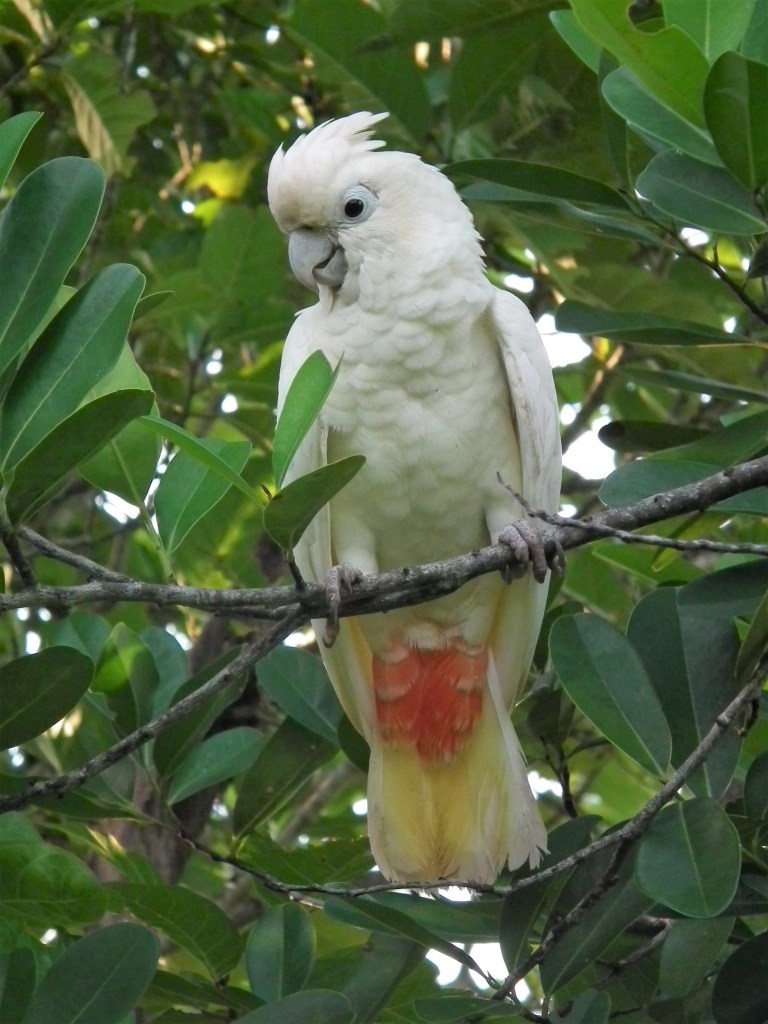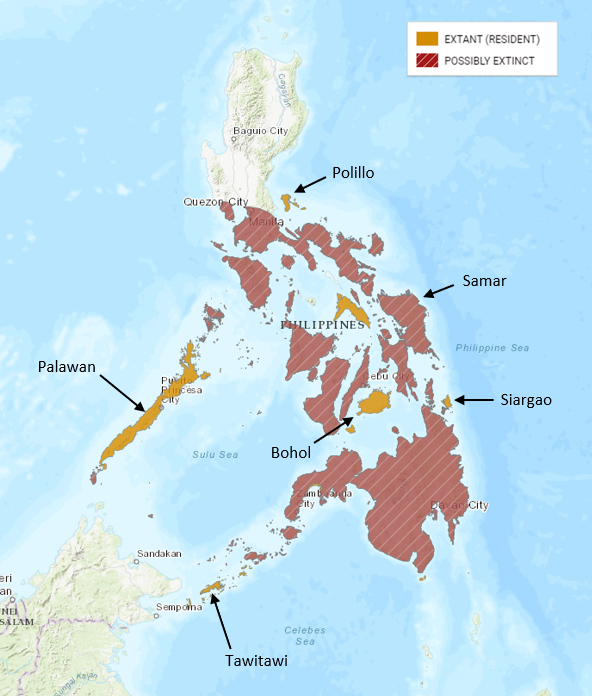Birdfinding.info ⇒ For several decades, the Philippine-endemic Red-vented Cockatoo (known locally as the Katala) was severely persecuted for the illegal cagebird trade, and it is listed as critically endangered. Starting in 1998, an intensive conservation program launched by the Katala Foundation has produced localized increases, and a slow recovery seems to be underway. Its global stronghold is along the coasts of Palawan—especially adjacent Rasa Island (open to visitors from July to December), which has become a source of immigrants to the main island around Narra. A flock inhabits the Iwahig Penal Colony property near Puerto Princesa, and can sometimes be seen visting parks and gardens of the city.
Red-vented Cockatoo
Cacatua haematuropygia
Endemic to the Philippines, but extirpated from most of its historical range such that it is mostly confined to Palawan and the Sulu Islands, with a few scattered relict populations elsewhere.
Occurs in humid lowland forests, including second growth and degraded woodlands, mainly in coastal areas with mangroves and nearshore islets where it can roost and nest in seclusion. Often feeds in corn and rice fields, a habit that has contributed to its persecution.
In 2016, the global population was estimated at 650-1,120 birds, with the majority (580-850) on Palawan and adjacent islets: mainly Rasa, Pandanan, and Dumaran. The next-largest remnant population was an estimated 50-150 on the Sulu Islands: mainly Tawitawi.
Much smaller groups (each about twenty or fewer) have persisted, at least into the 2010s, on Polillo, Bohol, and northern Samar. In the southeast, Siargao (northeast of Mindanao) has been selected as a reintroduction site.
The Rasa Island population numbered 23 individuals in 1998, but conservation measures enabled it to recover to 200 by 2008, 300 by 2015, and approximately 400 in 2019. In 2011 alone, the island produced at least 75 juveniles.
The Pandanan Island population was approximately 40 in 2008, but protection against capture of chicks from the nests had enabled it to rebound to approximately 300 by 2018. The conservation project has been expanded to adjacent Bugsuk Island.
Formerly inhabited the entire Philippine archipelago north to the Manila area. Populations were generally intact until at least 1950. Trapping escalated substantially in the 1970s, but it remained fairly common across much of its range into the early 1980s. By the late 1980s, however, it had become rare and localized.
Identification
Unmistakable: a small white cockatoo with pale-tipped, pinkish-red undertail coverts. Also the only cockatoo native to the Philippines.
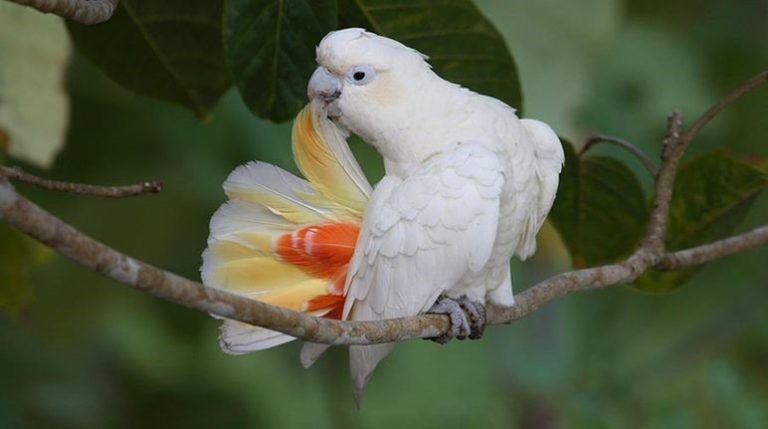
Red-vented Cockatoo, preening its tail feathers. (Palawan, Philippines.) © Peter Widmann
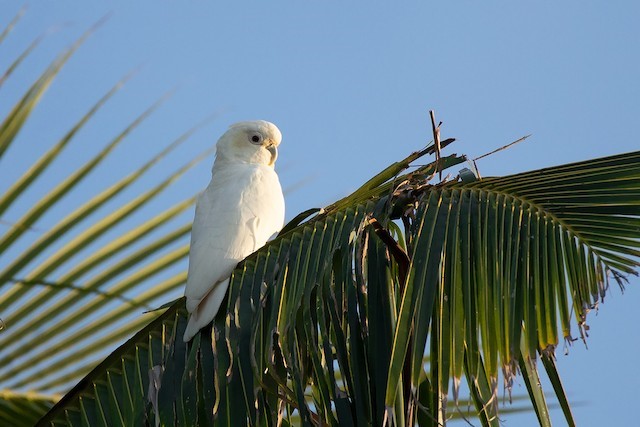
Red-vented Cockatoo, showing all-white upperparts. (Palawan, Philippines.) © Ayuwat Jearwattanakanok
The bill is pale ivory or horn-colored. The orbital skin is white and may appear slightly bluish or pinkish.

Red-vented Cockatoo. (Iwahig, Palawan, Philippines; March 12, 2012.) © Luis Mario Arce
It has a medium-sized, all-white crest that it usually keeps lowered. When raised, it can extend two or three inches above the head.
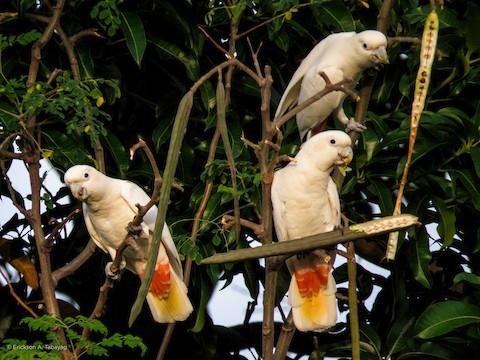
Red-vented Cockatoos showing their distinctive undertail coloration. (Palawan, Philippines.) © Erickson Tabayag
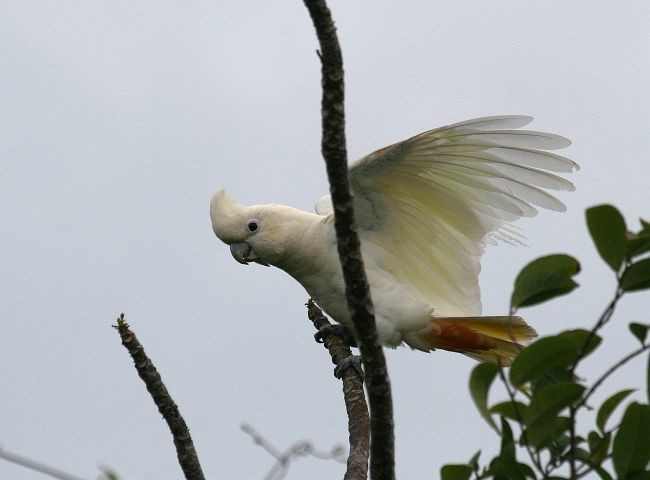
Red-vented Cockatoo, with its crest raised. (Rasa, Palawan, Philippines; March 6, 2008.) © Marc Ameels
As in other white cockatoos, the undersides of the wings have a pale yellowish wash. Unlike the others, the underside of the tail is a deeper shade of yellow.

Red-vented Cockatoo, in flight, showing red undertail coverts and yellowish wash on the underwings. (Palawan, Philippines.) © Ayuwat Jearwattanakanok
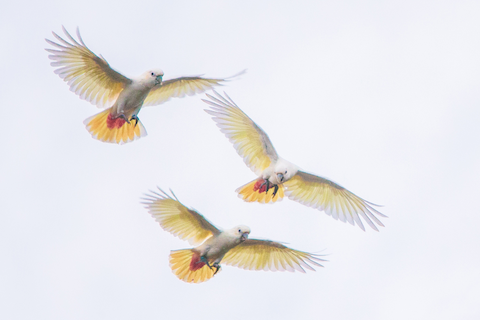
Red-vented Cockatoo, in flight, showing red undertail coverts and yellowish wash on the underwings. (Palawan, Philippines.) © Vinz Pascua
Voice. Typical calls are harsh, hoarse, guttural barks, given in series: St. Paul National Park, Palawan, Philippines; January 12, 1997. © Filip Verbelen
Sometimes less harsh, more mournful: St. Paul National Park, Palawan, Philippines; January 12, 1997. © Filip Verbelen
Some calls are higher and thinner: Tawitawi, Sulu Islands, Philippines. © Des Allen
Notes
Monotypic species. Also known as the Philippine Cockatoo.
IUCN Red List Status: Critically Endangered.
Additional Photos of Red-vented Cockatoo

Red-vented Cockatoos. (Princesa Garden, Palawan, Philippines; November 3, 2018.) © Matthew Kwan
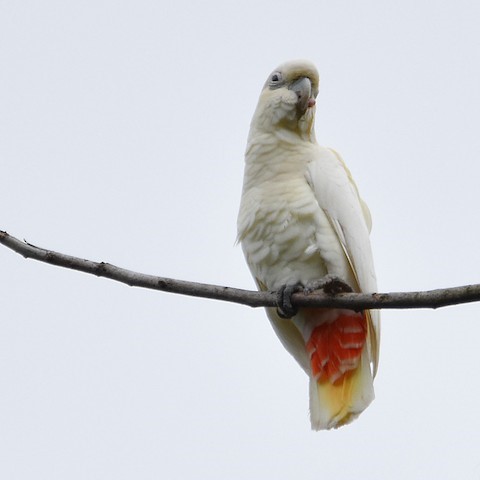
Red-vented Cockatoo. (Palawan, Philippines.) © Chris Chafer

Red-vented Cockatoo. (Narra, Palawan, Philippines; January 12, 2015.) © Yann Muzika
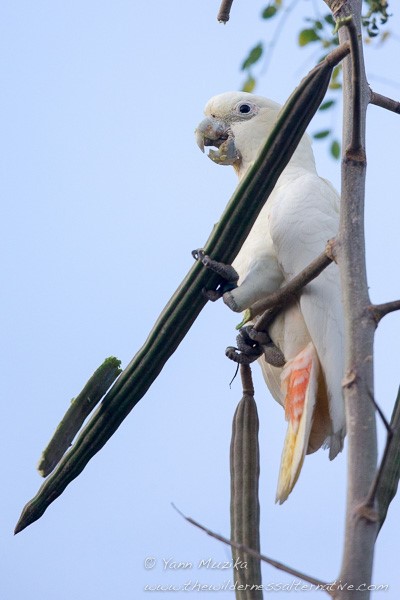
Red-vented Cockatoo. (Narra, Palawan, Philippines; January 12, 2015.) © Yann Muzika

Red-vented Cockatoo, dorsal view. (Palawan, Philippines.) © Ayuwat Jearwattanakanok
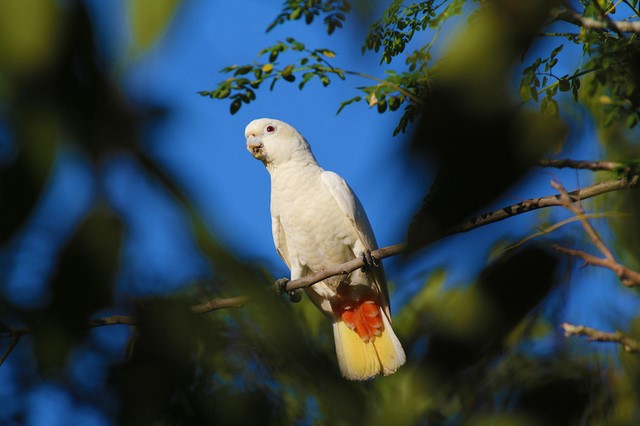
Red-vented Cockatoo, ventral view. (Palawan, Philippines.) © Peter Widmann
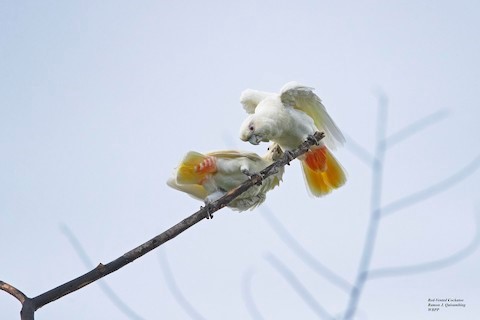
Red-vented Cockatoos. (Palawan, Philippines.) © Ramon Quisumbing
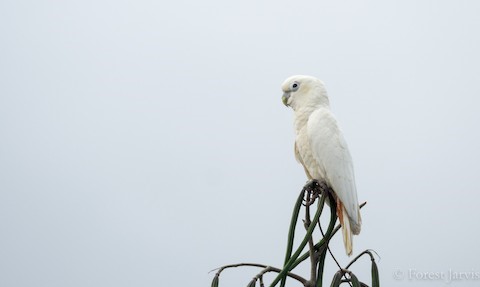
Red-vented Cockatoo, lateral view. (Palawan, Philippines.) © Forest Jarvis

Red-vented Cockatoo, in flight, showing red undertail coverts and yellowish wash on the underwings. (Palawan, Philippines.) © Ayuwat Jearwattanakanok

Red-vented Cockatoo, in flight, showing red undertail coverts and yellowish wash on the underwings. (Palawan, Philippines.) © Ramon Quisumbing

Red-vented Cockatoo, in flight, showing red undertail coverts and yellowish wash on the underwings. (Palawan, Philippines.) © Ayuwat Jearwattanakanok
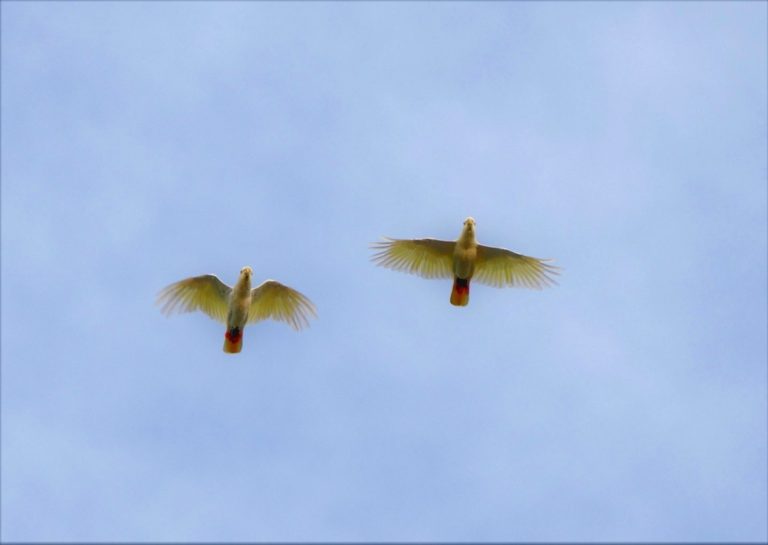
Red-vented Cockatoos, in flight, showing red undertail coverts and yellowish wash on the underwings. (Palawan, Philippines; March 2019.) © gery-dupas

Red-vented Cockatoos, in flight, showing red undertail coverts. (Palawan, Philippines.) © Ayuwat Jearwattanakanok
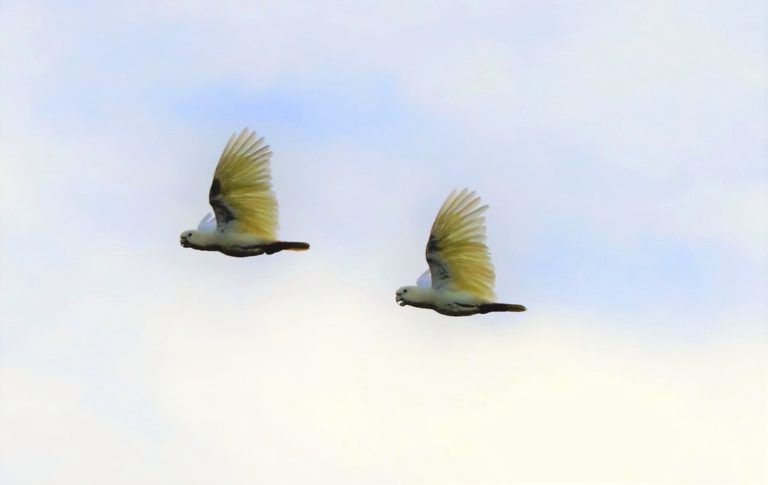
Red-vented Cockatoos, in flight, showing yellowish wash on the underwings. (Palawan, Philippines; March 2019.) © gery-dupas
References
BirdLife International. 2017. Cacatua haematuropygia. The IUCN Red List of Threatened Species 2017: e.T22684795A117578604. https://dx.doi.org/10.2305/IUCN.UK.2017-3.RLTS.T22684795A117578604.en. (Accessed September 13, 2021.)
Cameron, M. 2007. Cockatoos. CSIRO Publishing, Collingwood, Victoria, Australia.
eBird. 2021. eBird: An online database of bird distribution and abundance. Cornell Lab of Ornithology, Ithaca, N.Y. http://www.ebird.org. (Accessed September 9, 2021.)
Forshaw, J.M. 2010. Parrots of the World. Princeton University Press.
Juniper, T., and M. Parr. 1998. Parrots: A Guide to Parrots of the World. Yale University Press.
Katala Foundation. 2020. Learn about the Philippine cockatoo. https://www.philippinecockatoo.org/philippine%20cockatoo.htm. (Posted July 30, 2020. Accessed September 13, 2021.)
Michigan State University. 2021. AVoCet: Avian Vocalizations Center. https://avocet.integrativebiology.natsci.msu.edu/. (Accessed September 11, 2021.)
Mulawki, E.J. 2014. The Cockatoos: A Complete Guide to the 21 Species. McFarland Publishing, Jefferson, N.C.
Taboada, J.J. 2019. Narra registers zero Katala poaching in three years. Palawan News (June 28, 2019), https://palawan-news.com/narra-registers-zero-katala-poaching-in-three-years/.
